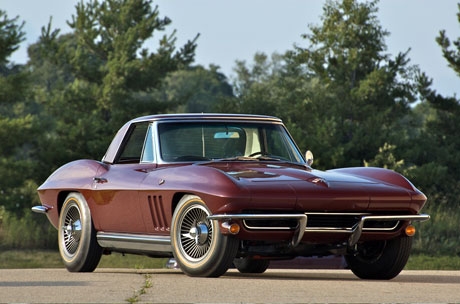Corvette collectors will find this 1965 327 convertible almost irresistible. Forty-five years after it was ordered new with the popular 327/300 L75 engine and Powerglide transmission, it remains unrestored, except for a single repaint in its original Milano Maroon. The car arrived from the factory nicely outfitted with power steering and power disc brakes—the first time this feature was available in the Corvette—and both soft and hard tops for every kind of motoring. Today it rolls on a set of reproduction cast-aluminum wheels wearing period-correct Goodyear Goldline tires, a very good choice for this car’s color scheme.
Contrasting with the maroon finish is the original and very well preserved original-code 438 white leather interior, which features its own contrast in the black carpeting and dash. The driver is treated to a three-spoke teakwood steering wheel mounted on a telescopic column, and an AM/FM radio provides the tunes. Beyond the teakwood wheel is the view no Corvette lover can get enough of: the classic ’Vette instrument panel. Look closely at the odometer, and you will see that this wonderful matching-numbers example has accumulated a mere 21,425 miles.
Originally a California car, this Corvette has a solid owner history and comes with full documentation, including the Protect-O-Plate, a letter from the dealer, 1965 California registration, and smog inspection.
SCM Analysis
Detailing
| Vehicle: | 1965 327/300 Convertible |
| Years Produced: | 1965 |
| Number Produced: | 15,378 |
| Original List Price: | $4,106 |
| SCM Valuation: | $38,000-$60,000 |
| Tune Up Cost: | $400–500 |
| Distributor Caps: | $25 |
| Chassis Number Location: | Cross brace under glovebox |
| Engine Number Location: | On block in front of right cylinder head |
| Club Info: | National Corvette Restorers Society |
| Website: | www.ncrs.org |
| Alternatives: | 1969–70 Ford Mustang GT convertible 1967–68 Chevrolet Camaro SS convertible 1960–61 Porsche 356B cabriolet |
| Investment Grade: | B- |
This car sold for $49,820, including buyer’s premium, at the Mecum High Performance Auction in St. Charles, Illinois, on October 2, 2009.
Don’t you just love auction catalog writers? Along with real-estate advertisements, these spin doctors can conjure up the most positive descriptions. In the case of this particular mid-year convertible, “popular 327/300 L75 engine and Powerglide transmission” actually means one of the least-horsepower-engines you could get in 1965, with the least desirable transmission; “unrestored, except for a single repaint” suggests the original paint was somehow damaged or degraded; and “reproduction cast-aluminum wheels” could possibly mean original steel units were replaced by upscale aluminum re-pops for auction.
But balancing these negatives were some genuine positives, highlighted by the matching chassis and engine numbers, low 21,425 claimed total miles, soft and hard tops, and dated key documentation, including ownership history.
In terms of options, among the 31 Corvette RPOs (plus leather seats) available for 1965, this car is not highly equipped. Although it has leather seats, power steering, and an AM/FM radio, it still lacks any of the four available high-horsepower engines (such as the first-year big-block 396), air conditioning, power windows, or Positraction, and its Powerglide tranny further holds it back compared to the more plentiful 4-speed cars.
California black plate shake-up
One big strength is the “California car” distinction, an important indicator of a generally rust-free living environment. While the ’65 California paperwork proves this car’s Golden State heritage, the term “California car” actually got a shake-up last summer when the state began allowing the transfer of vintage black-and-yellow plates to any 1963–69 car.
That sucks, because now some rust-infested claptrap from Milwaukee can become a “California car” for a small fee plus a set of eBay plates. Fortunately, such poseurs will never have original California documentation, and buyers of “California cars” should hereafter make sure to ask for California ownership history instead of just taking the wearing of black plates as proof.
Back to the Corvette at hand. What I like most about this car is its low mileage, its California history, and the idea (implied but not stated) that it has not been jacked with. I would much rather buy a low-mileage survivor/driver with known history than a Priscilla, Queen of the Auction with unknown history and an overload of replica parts.
Other plusses like power discs and power steering make this ’65 usable in city traffic, and the two tops expand its overall usefulness. But again, the car’s mileage is really the ace in the hole. Even with 100 miles more added every single weekend, it would take 15 years to reach the 99,000-mile mark, whereupon the owner could still sell with less than 100k on the clock. And because this Sting Ray has already gotten a repaint and replica wheels, the new owner can drive it like a normal car and not worry about every additional chip or blemish.
On the financial end of the deal, the buyer is looking really good at $50,000, because he gets a sanitary and ready-to-use car for less than the restoration cost of a needy beater or any fuel-injected or big-block Corvette, along with the pride of ownership that a substantially original car provides.
Looking at it from a different angle, if the buyer had moved into a comparably priced new Lexus IS 350 convertible instead, most of the purchase price would spin into Depreciation Ditch after only five years. All things considered, I’d call this a solid buy on a solid little car. (Introductory description courtesy of Mecum Auctions.
